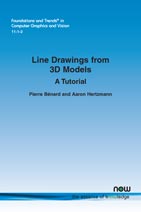Line Drawings from 3D Models: A Tutorial
By Pierre Bénard, LaBRI – Inria, France, pierre.benard@labri.fr | Aaron Hertzmann, Adobe Research, USA, hertzman@dgp.toronto.edu
Abstract
This tutorial describes the geometry and algorithms for generating line drawings from 3D models, focusing on occluding contours. The geometry of occluding contours on meshes and on smooth surfaces is described in detail, together with algorithms for extracting contours, computing their visibility, and creating stylized renderings and animations. Exact methods and hardware-accelerated fast methods are both described, and the trade-offs between different methods are discussed. The tutorial brings together and organizes material that, at present, is scattered throughout the literature. It also includes some novel explanations, and implementation tips. A thorough survey of the field of non-photorealistic 3D rendering is also included, covering other kinds of line drawings and artistic shading.
Line Drawings from 3D Models: A Tutorial
Drawing is the starting point for many kinds of tasks, for everyone from children making pictures to professional architects sketching ideas. Drawing seems to be fundamentally connected to how we represent the world visually. Most computer graphics focuses on realistic visual simulation, but over the past few decades, line drawing algorithms have matured, providing the ability to automatically create reasonable line drawings from 3D geometry.
This tutorial provides a detailed guide to the mathematical theory and computer algorithms for line drawing of 3D objects. It focuses on the curves known as contours as they are the most important curves for line drawing of 3D surfaces. The authors describe the different algorithms required to compute and render these curves, before going on to explain boundary curves and surface-surface intersection curves. The tutorial concludes with other topics in 3D non-photorealistic rendering including: other types of curves, stroke rendering, and non-photorealistic shading.
Line Drawings from 3D Models: A Tutorial is a concise, yet comprehensive, introduction to an increasingly important topic in computer graphics. The extensive bibliography is invaluable for readers wishing to further their own research in the area.
